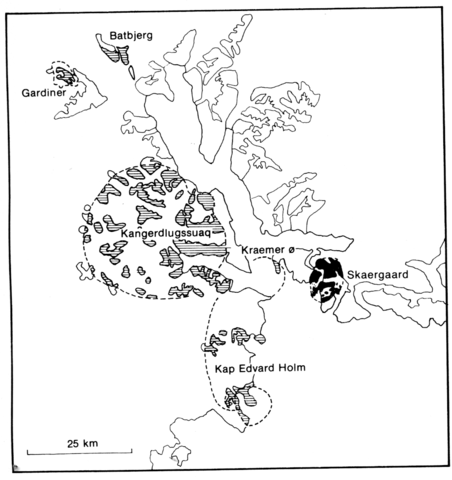stripes
The ring-shaped, 5 km diameter Gardiner ultramafic complex is exposed on the most westerly nunatak west of the head of Kangerdlugssuaq Fjord. It is emplaced in Precambrian granitic gneisses and contemporaneous alkaline lavas which include nephelinites, ankaramites and hawaiites. There is a very narrow zone of fenitization in the gneisses. Nielsen (1980) divides the rocks of the complex into four age groups: (1) an older ultramafic cumulate series that forms 80% of the outcrop; (2) a suite of dykes and sheets ranging from shonkinites to sodalite and nepheline syenites; (3) a massive ring dyke of melilitolite and ijolite with related melteigite, syenite and carbonatite; and (4) a terminal dyke suite of alkaline pyroxenite, nepheline syenite and apatite rocks. The ultramafic cumulate series (Nielsen, 1981) is dominated by the oldest rocks of the complex, which are dunites, and there are several rings of pyroxenite alternating with them. The dunites in the central area have been replaced or metasomatically altered by the later melilitolites. The unaltered dunites comprise olivine and spinel and pass into clinopyroxene-bearing dunites. The metasomatism caused by melilitolite emplacement produced glimmerites passing outward into phlogopite-veined rocks. The 'pyroxenite' (peridotite) rings within the dunites are weakly layered and comprise 0-93% olivine, 5-75% clinopyroxene, spinel, usually magnetite, and occasionally hornblende. The dyke rocks of the second phase are composed of varying proportions of perthite, albite and microcline, aegirine-augite/Ti-rich aegirine, sodalite, nepheline, Mg-katophorite, Mg-arfvedsonite, biotite and accessories, including ramsayite and pyrochlore (Nielsen, 1979). The principal ring dyke of the third phase is composed of melilite-bearing rocks which are sometimes layered and vary from afrikandite in the interior, consisting mainly of perovskite, magnetite and apatite enclosed poikilitically by melilite, to uncompahgrites near the margins containing clinopyroxene and phlogopite. At high elevations the ring dyke passes into phlogopite afrikandites and turjaites of phlogopite, melilite, nepheline, magnetite, calcite, perovskite and apatite, together with veins containing 85-90% calcite, 5-10% melanite and accessories (Nielsen, 1980), and include varieties described as tawites (sodalite-rich) and urtites (Frisch and Keusen, 1977, pp. 26-9). Outside the ring dyke but related to it are sovite dykes and sheets. A ring dyke of ijolite lies inside the melilitolite dyke in its eastern part. Rock analyses will be found in Frisch and Keusen (1977) and Nielsen (1980 and 1981) and mineral analyses in Nielsen (1979, 1980 and 1981). Nielsen and Buchardt (1985) give Rb, Sr and Sr isotope data for a range of rocks and C and O isotope data for sovite and calcite; they also tabulate 87Sr/86Sr ratios for Lower Tertiary rocks of East Greenland.
FRISCH, W. and KEUSEN, H. 1977. Gardiner intrusion, an ultramafic complex at Kangerdlugssuaq, East Greenland. Bulletin, Gronlands Geologiske Undersogelse, 122: 1-62.
GLEADOW, A.J.W. and BROOKS, C.K. 1979. Fission track dating, thermal histories and tectonics of igneous intrusions in East Greenland. Contributions to Mineralogy and Petrology, 71: 45-60.
NIELSEN, T.F.D. 1979. The occurrence and formation of Ti-aegirines in peralkaline syenites: an example from the Tertiary ultramafic alkaline Gardiner complex, East Greenland. Contributions to Mineralogy and Petrology, 69: 235-44.
NIELSEN, T.F.D. 1980. The petrology of a melilitite melteigite, carbonatite and syenite ring dike system, in the Gardiner complex, East Greenland. Lithos, 13: 181-97.
NIELSEN, T.F.D. 1981. The ultramafic cumulate series, Gardiner complex, East Greenland: cumulates in a shallow level magma chamber of a nephelinite volcano. Contributions to Mineralogy and Petrology, 76: 60-72.
NIELSEN, T.F.D. and BUCHARDT, B. 1985. Sr-C-O isotopes in nephelinitic rocks and carbonatites, Gardiner complex, Tertiary of East Greenland. Chemical Geology, 53: 207-17.


